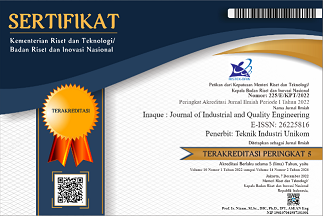KAJIAN DRUM-BUFFER-ROPE BERBASIS THEORY OF CONTRAINT UNTUK MENYEIMBANGKAN ALIRAN PRODUKSI
DOI:
https://doi.org/10.34010/iqe.v8i1.2764Abstract
Production process in making of furniture is found a bottleneck of work in process in particular work station. This is due to the availability of work station that has no capacity to meet the demand, making the production flows imbalanced, and to the inexistence of good management in determining the production schedules so that the production targets take too long time, which is in turn too long to reach the consumers. An optimization of work station that has no capacity for meeting a demand in this research is attempted by using the method of Drum-Buffer-Rope in Theory of Constraints (TOC) and with the approach of Linear Program. In TOC an identification of work station that has no capacity to satisfy a demand is conducted. In this research it is reviewed three kinds of products: rose grooming-rooms, Monaco living chairs and Rosalinda dish tables. They are processed in four work stations. Based on the application of Drum-Buffer-Rope method in Theory of Constraints (TOC), it is known that the sand papering station is a work station without a capacity to meet a demand. The results of investigation indicate that all production targets could not be achieved; therefore, a production priority with linear program is made. From this production priority, it is given the scheduling of production that provide a shorter time of make span, so that idle time in each work station is minimize.
Downloads
Published
Issue
Section
License
Authors who publish this journal agree to the following terms:
The author holds the copyright and grants the right of the first publication journal to enable INAQUE to share the work with acknowledgment of the author's work and early publications in this journal.
Authors may include separate additional contractual arrangements for the non-exclusive distribution of the journal's published version (for example, submit to an institutional repository or publish in a book), with the acknowledgment of its initial publication in this journal
Authors are permitted and encouraged to post their work online before and during the delivery process, as it may lead to productive exchanges, as well as quotations of previously published and longer works








